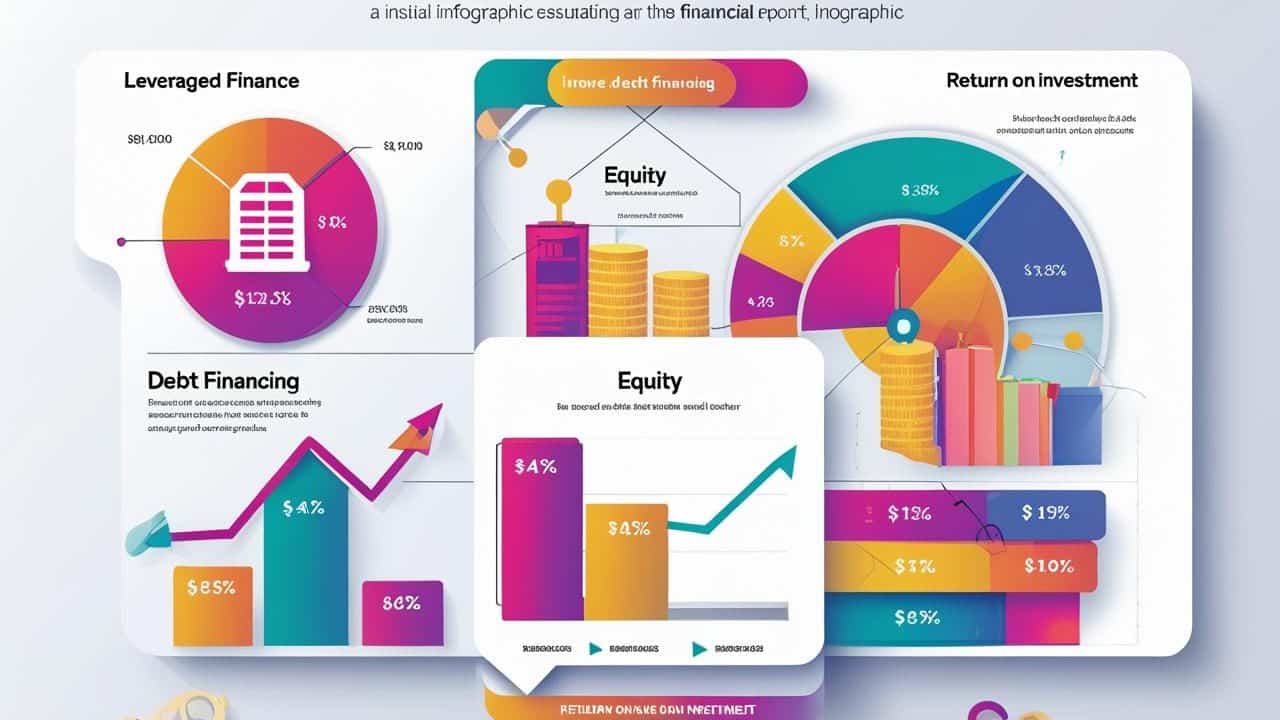- Home
- Finance & Side Hustles
- Leveraged Finance: All You Nee ...

The Power (and Pitfalls) of Leveraged Finance
When Microsoft acquired LinkedIn for $26 billion in 2016, leveraged finance played a starring role. But what fuels these high-stakes deals, and how can businesses harness debt strategically without drowning in risk?
Leveraged finance—the practice of using borrowed capital to amplify returns on investments, acquisitions, or expansions—has become a cornerstone of modern corporate strategy. From private equity buyouts to aggressive growth campaigns, debt-driven financing enables companies to achieve outsized returns. However, as the collapse of high-profile deals like Toys “R” Us illustrates, mismanaged leverage can trigger financial ruin. This guide unpacks the mechanics, benefits, and risks of leveraged finance, offering actionable insights for finance professionals, investors, and business leaders navigating today’s complex financial landscape.
What Is Leveraged Finance? Breaking Down the Basics
At its core, leveraged finance involves raising debt through instruments like leveraged loans or high-yield bonds to fund transactions where the borrower’s cash flow or assets secure the debt. Unlike traditional corporate lending, leveraged finance typically serves borrowers with higher debt levels or lower credit ratings, making it a linchpin of private equity, mergers and acquisitions (M&A), and corporate restructuring.
Key players in this ecosystem include:
- Private equity firms: Specialize in acquiring undervalued companies using debt-heavy structures.
- Investment banks: Structure and syndicate loans, balancing risk for institutional investors.
- Non-bank lenders: Offer flexible financing options outside traditional banking channels.
Common use cases range from leveraged buyouts (LBOs), where debt fuels acquisitions, to recapitalizations that optimize a company’s debt-equity mix, and M&A financing that supports mergers or expansions.
The Mechanics of Leveraged Finance
Leveraged finance operates through two primary instruments: leveraged loans and high-yield bonds. Leveraged loans are floating-rate, senior secured debts often syndicated by banks and tracked by indices like the S&P/LSTA Leveraged Loan Index. These loans appeal to borrowers seeking flexibility amid interest rate fluctuations. High-yield bonds, on the other hand, are fixed-rate instruments rated below investment grade (BB+ or lower), attracting investors willing to bet on turnaround stories.
- Leveraged Loans: Floating-rate, senior secured debts often syndicated by banks and tracked by indices like the S&P/LSTA Leveraged Loan Index. These loans appeal to borrowers seeking flexibility amid interest rate fluctuations.
- High-Yield Bonds: Fixed-rate instruments rated below investment grade (BB+ or lower), attracting investors willing to bet on turnaround stories.
A third layer, mezzanine financing, bridges the gap between senior debt and equity. This hybrid instrument often includes equity kickers like warrants, offering lenders a share of future upside. Lenders assess risk using metrics like debt-to-EBITDA ratios, with middle-market LBOs typically securing 4x to 6x EBITDA. For example, a software company generating 10 million EBITDA might borrow assuming a 5x leverage ratio.
Why Leveraged Finance? Benefits and Risks
The allure of leveraged finance lies in its ability to amplify returns. Consider a $100 million acquisition funded with 20% equity and 80% debt: if the asset appreciates, the equity holder’s returns multiply. Debt also offers tax efficiency, as interest expenses reduce taxable income, and structures like covenant-lite loans or payment-in-kind (PIK) notes provide flexibility for cash-strapped borrowers.
However, the risks are equally stark:
- Default Risk: Over-leverage can strain cash flow during downturns, as seen in J.Crew’s 2020 bankruptcy.
- Interest Rate Sensitivity: Floating-rate loans expose borrowers to rising costs as central banks tighten monetary policy.
- Covenant Breaches: Violating terms (e.g., failing to meet EBITDA thresholds) can trigger defaults.
The 2017 collapse of Toys “R” Us, driven by unsustainable debt from its 2005 LBO, remains a cautionary tale of mismanaged leverage.
Example of How Leveraged Finance Increases Returns
To understand the power of leveraged finance, consider a hypothetical acquisition of Company X, a mid-sized software firm with $20 million in annual EBITDA.
Scenario:
- Purchase Price: $200 million (10x EBITDA multiple).
- Capital Structure:
- Equity Investment: $50 million (25% of the purchase price).
- Debt Financing: $150 million (75% debt at 8% interest).
Over 3 Years:
- Operational Improvements: Company X streamlines operations, boosting EBITDA to $30 million.
- Exit Valuation: The company is sold at the same 10x multiple, now valued at $300 million.
Return Calculation:
- Debt Repayment: 150million(principal)+150million(principal)+36 million (interest over 3 years) = $186 million.
- Net Proceeds: 300million(saleprice)–300million(saleprice)–186 million (debt repayment) = $114 million.
- Equity Return: 114million(proceeds)–114million(proceeds)–50 million (initial equity) = $64 million profit.
- ROE (Return on Equity): (64M/64M/50M) = 128% return.
Without Leverage:
If the same $200 million acquisition were funded entirely with equity:
- Equity Return: 300million(saleprice)–300million(saleprice)–200 million (initial equity) = $100 million profit.
- ROE: (100M/100M/200M) = 50% return.
Key Takeaway:
Leveraged finance amplified returns from 50% to 128% by using debt strategically. However, this upside hinges on two critical factors:
- Operational Success: The company must grow EBITDA to service debt and justify a higher exit value.
- Debt Discipline: Over-leverage (e.g., 90% debt) could sink the deal if EBITDA stagnates.
This example mirrors real-world successes like Thoma Bravo’s acquisition of cybersecurity firm Proofpoint in 2021. By combining targeted debt with operational expertise, the PE giant achieved a 3x return within 18 months.
The Role of Private Equity in Leveraged Finance
Private equity (PE) firms are pivotal players in leveraged finance, using debt to execute LBOs. By acquiring companies with 60–80% debt, PE firms aim to streamline operations, boost valuations, and exit profitably via IPOs or sales. Recent trends highlight the rise of direct lending by non-bank institutions like Ares Management, which offer faster, bespoke financing.
ESG considerations are also reshaping the field:
- Sustainability-linked loans: Tie interest rates to environmental or social targets.
- Green bonds: Fund eco-friendly projects, such as renewable energy infrastructure.
For instance, a telecom company might secure a loan with lower rates if it reduces carbon emissions by 15% within five years.
Trends and Challenges
The post-pandemic era has ushered in a refinancing wave, with $650 billion in leveraged loans maturing by 2025. Borrowers face pressure amid rising rates, while regulators tighten guidelines to curb excessive risk-taking. The Federal Reserve’s leveraged lending rules, for example, discourage banks from underwriting loans exceeding 6x debt-to-EBITDA for non-financial companies.
Technology is also transforming the sector:
- AI-driven risk modeling: Predicts defaults by analyzing cash flow patterns and market trends.
- Blockchain platforms: Streamline syndicated loan management (e.g., Finastra’s Fusion LenderComm).
These innovations promise greater efficiency but require firms to adapt swiftly.
How to Structure a Leveraged Finance Deal?
Structuring a leveraged finance deal begins with sourcing viable targets, such as SaaS companies with recurring revenue. Due diligence follows, stress-testing cash flow projections and asset quality to avoid overpayment. The capital stack must balance senior debt (lowest cost but strictest terms), mezzanine financing, and equity.
Negotiating terms is critical: covenant flexibility, manageable amortization schedules, and prepayment penalties can make or break a deal. Finally, exit planning ensures liquidity. Successful exits might involve taking a company public, selling to a strategic buyer, or executing a dividend recapitalization to return cash to investors.
The Rise and Fall of TXU Energy’s $45B LBO
In 2007, KKR and TPG acquired TXU Energy in the largest LBO ever. The deal aimed to modernize Texas’s power grid, but $40 billion in debt and plummeting energy prices led to a 2014 bankruptcy. While the PE firms recouped some losses via asset sales, the collapse underscored the perils of over-leverage and poor market timing.
Key lessons include the need for debt discipline—even in “recession-proof” sectors—and anticipating disruptive trends, such as renewable energy’s rise.
FAQs: Answering Key Questions
- Q: How does leveraged finance differ from traditional corporate lending?
- Targets riskier borrowers with higher debt levels.
- Funds acquisitions rather than daily operations.
- Involves structured instruments like leveraged loans or high-yield bonds.
- Q: Which industries rely most on leveraged finance?
- Telecom (infrastructure upgrades).
- Healthcare (acquisitions of specialized clinics).
- Tech (growth-stage funding).
- Q: How do economic downturns impact leveraged loans?
- Defaults spike as earnings shrink.
- Senior secured lenders recover 60–80% vs. 20–40% for unsecured creditors.
Leveraged Finance as a Double-Edged Sword
Leveraged finance remains a potent tool for growth, but its risks demand vigilance. For every Microsoft-LinkedIn success, there’s a cautionary tale like TXU. The key lies in disciplined structuring, rigorous due diligence, and aligning debt with long-term strategy.
As private equity innovates and regulators tighten rules, businesses must balance ambition with prudence. In 2025 and beyond, leveraged finance will reward those who wield it wisely—and penalize the reckless.






